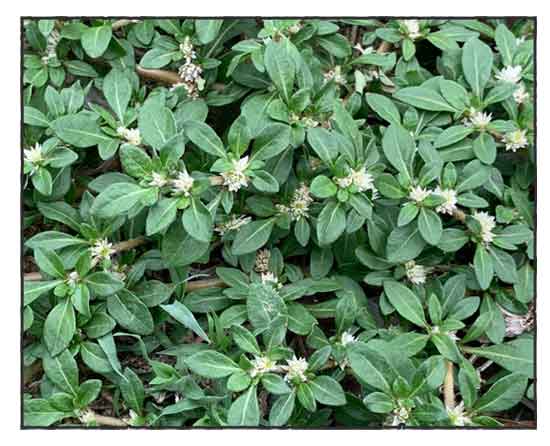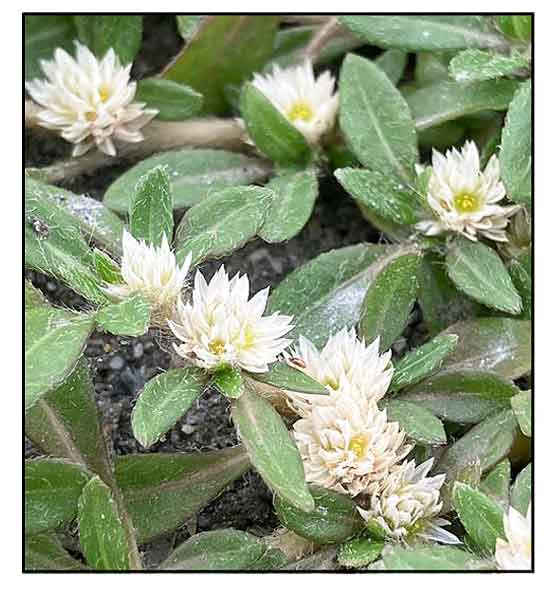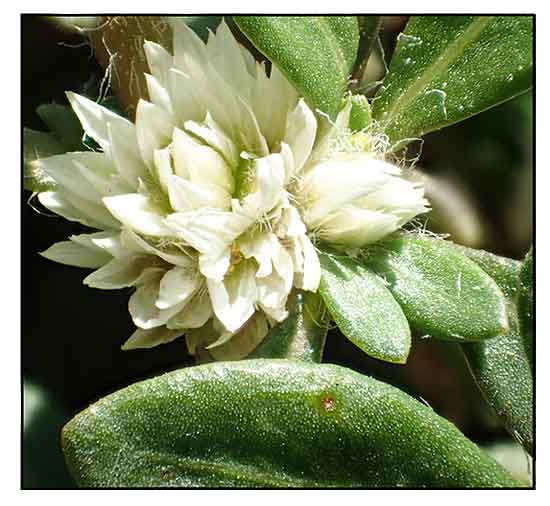Gen info
- Alternanthera is a genus of flowering plants in the family Amaranthaceae. It is a widespread genus with most species occurring in the tropical Americas, and others in Asia, Africa, and Australia. Plants in the genus are generally called joyweeds, or Joseph's coat. Some species are notorious noxious weeds. (8)
- The genus Alternanthera comprises 139 species including 14 species used traditinally for the treatment of various ailments such as hypertension, pain, inflammation, diabetes, cancers, microbial infections and mental disorders.
 Botany Botany
• Herbs perennial. Stem densely barbellate hairy, glabrescent. Leaf blade oblanceolate or spatulate, 1.5-2 × 0.3-0.5 cm, abaxially barbellate hairy, apex obtuse to rounded. Heads sessile, ovoid to globose, often hairy at base. Tepals white, ovate-oblong, scarious, hairy along veins, outer 3 segments: 3-veined in proximal half, inner 2 somewhat laterally compressed, 1-veined, apex acute to mucronate. Stamens 5; anthers yellow, ellipsoid; staminodes 3- or 4-toothed, ca. 1/2 as long as stamens; stigma capitate. Utricle brown, obcordate. (Flora of China)
• Soft-stemmed prostrate perennial herb, hairy, later glabrescent; leaves elliptic, ovate-rhombic to spatulate, up to 2 cm long, hairy beneath; flower greenish-white in axillary sessile heads about 1 cm in diam; bracts less than half as long as tepals ; tepals similar, white, ovate-oblong, 3-5 mm long, acuminate, outer 3 3-veined, inner 2 1-veined; pseudostaminodes shorter than stamens, 3-4-toothed; utricle obcordate, brown. (eFlora of India)
Distribution
- Introduced, naturalized.
- In Giuimaras, Quezon, Mindoro, Mindanao.
- Native to Argentina Northeast, Argentina Northwest, Belize, Bolivia, Brazil North, Brazil Northeast, Brazil South, Brazil Southeast, Brazil West-Central, Colombia, Costa Rica, Cuba, Dominican Republic, Ecuador, French Guiana, Guyana, Haiti, Honduras, Jamaica, Leeward Is., Mexico Gulf, Mexico Northeast, Mexico Northwest, Mexico Southeast, Mexico Southwest, Nicaragua, Panamá, Paraguay, Peru, Puerto Rico, Suriname, Trinidad-Tobago, Turks-Caicos Is., Uruguay, Venezuela, Windward Is. (1)
 Constituents Constituents
- Phytochemical analysis of leaf and stem revealed presence of tannins, saponins, anthraquinones, glycosides, flavonoids, and reducing sugar. (see study below) (3)
- Phytochemical screening of air-dried leaves revealed presence of alkaloids, phenols, flavonoids, tannins, terpenoids, carbohydrates, saponins and steroids in the methanol extract; alkaloids, phenols, saponins, glycosides, terpenoids, and coumarins in aqueous extract; and alkaloids, terpenoids and reducing sugars in chloroform extract. Hexane extract only yielded alkaloids and terpenoids. (see study below) (4)
Properties
- Studies have suggested antimicrobial, antioxidant, thrombolytic, membrane stabilizing, anti-glucotoxic, antidiabetic properties.
Parts used
Leaves, stems.
 Uses Uses
Edibility
- In Sri Lanka, plant used in salads.
Folkloric
- No reported folkloric medicinal use in the Philippines.
- In Brazil folk medicine, used for the treatment of gout, hyperuricemia, rheumatic arthritis, etc. (2)
- In Sri Lanka, used for treatment of biliousness, dyspepsia, and sluggish liver. In Taiwan, used along with other medicinal plants for treatment of hepatitis, chest tightness, bronchitis, asthma, and other lung problems. (3)
- In traditional Chinese medicine, used for treatment of hyperuricemia, rheumatic arthritis, uremia, nephritis, gout, cystitis, diabetes, and systemic neuralgia.
Studies
• Standardization Profile: Study compared the standardization profiles of Alternanthera paronychioides and A. brasiliana. Physico-chemical analysis revealed the slightly acidic nature of both plants. Phytochemical analysis showed presence of phenol, terpenoids, and steroids as major secondary metabolites in both species. HPLC validated the existence of similar compounds in both Ap and Ab. PXRD revealed variance of elements present in both species. (2)
• Antimicrobial / Phytochemicals / Leaves: Study evaluated crude extracts of leaf and stem for invitro antimicrobial activities by agar disc diffusion method. The crude extracts of leaf and stem showed effective antimicrobial activity against Staphylococcus aureus, Escherichia coli, Salmonella typhi, and Bacillus subtilis, with MICs ranging between 5.0 and 37.0 mg/ml. (see constituents above) (3)
• Antibacterial / Antioxidant / Leaves: Study evaluated the air-dried aerial leaves of Alternanthera paronychioides and A. sessilis for phytochemicals, antioxidant and antimicrobial activities. Phytochemical constituents of A. sessilis showed more antioxidant potential than Ap in DPPH and H2O2 assays, but Alternanthera paronychioides showed more potential than As in FRAP assay. The extracts showed antibacterial activity against two strains, i.e., Escherichia coli (MTCC 443) and Staphylococcus aureus (MTCC 737). (4)
• Thrombolytic and Membrane Stabilizing Activities / Leaves and Stems: Study evaluated the thrombolytic and membrane stabilizing activities of crude ethanolic extracts of leaves and stems of Alternanthera paronychioides (Ap) and Vernonia patula (Vp). Streptokinase was used as standard for thrombolytic evaluation, and hypotonic solution induced human erythrocyte lysis model for membrane stabilizing activity. Leaves extract showed highest thrombolytic activity at 30.922% (p<0.001). Leaves and stem extracts of Ap showed 29.036% and 29.053% membrane stabilization. (5)
• Antiglucotoxic on Pancreatic ß-Cells / Antioxidant: Study evaluated the antioxidant and antiglucotoxic effects of ethanol extract of A. paronychioides (EEAP) on pancreatic ß-cells. Antioxidant assays showed ethanol extracts with highest antioxidant activity, with highest phenolic and flavonoid contents. HPLC-DAD identified two major polypenolics, ferulic acid and quercetin. EEAP and quercetin protected ß-cells from glucotoxicity through several mechanisms: (1) maintaining ß-cell viability; (2) suppressing reactive oxygen species production; (3) reducing features of apoptosis; (4) inhibiting activation of caspase-9 and caspase-3 and cleavage of poly (ADP-ribose) polymerase; (5) upregulating pancreatic and duodenal homeobox 1 gene expression and insulin secretagogue action of pancreatic ß-cells. Findings suggest potential preventive effects on diabetic glucotoxicity. (6)
Availability
- Wild-crafted.
|

![]()






